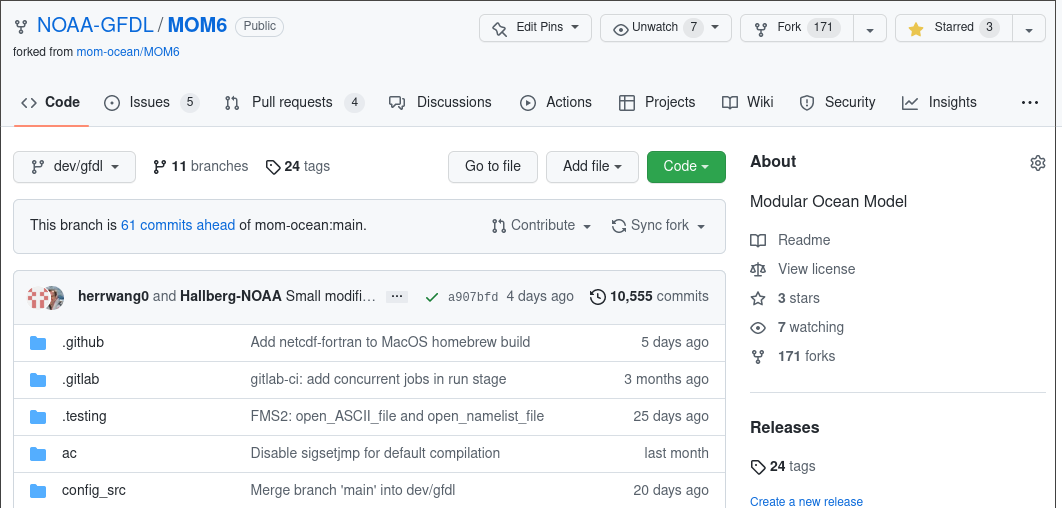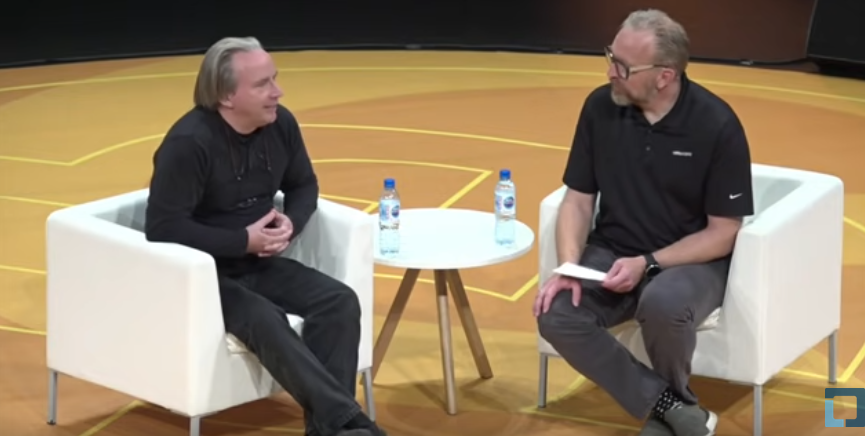
Contributing to MOM6
Marshall Ward
2022-10-18
Presentation is available at
The MOM6 Repository
Contained in the MOM6-examples repository
The MOM6 Consortium
Cloning
Get the repository:
$ git clone https://github.com/NOAA-GFDL/MOM6.git --recursiveThis creates a remote to NOAA-GFDL named origin.
$ git remote -v
origin https://github.com/NOAA-GFDL/MOM6.git (fetch)
origin https://github.com/NOAA-GFDL/MOM6.git (push)- Exercise:
Go to GitHub, fork MOM6, and create a new remote
Solution
Log into GitHub, go to MOM6:
Fork MOM6 to your account:
Create a remote to your new GitHub repo:
$ git remote add marshall https://github.com/marshallward/MOM6.gitSync to the remote:
$ git push marshall dev/gfdl
Branching
You want to start a new project! Create a new branch:
$ git checkout dev/gfdl # Switch to dev/gfdl
$ git pull # Sync with origin
$ git branch my_feature # Create a new branch
$ git checkout my_feature # Switch to new branchChanges to my_feature will not alter dev/gfdl.
Changing the Code
Add a welcome message:
diff --git a/src/core/MOM.F90 b/src/core/MOM.F90
index 267a162b0..17d5259c8 100644
--- a/src/core/MOM.F90
+++ b/src/core/MOM.F90
@@ -1912,6 +1912,8 @@ subroutine initialize_MOM(Time, Time_init, param_file, dirs, CS, restart_CSp, &
CS%Time => Time
+ print *, "Welcome to MOM6!"
+
id_clock_init = cpu_clock_id('Ocean Initialization', grain=CLOCK_SUBCOMPONENT)
call cpu_clock_begin(id_clock_init)Or use your patch from "MOM6 internals"
Diagnostic patch
diff --git a/src/core/MOM_CoriolisAdv.F90 b/src/core/MOM_CoriolisAdv.F90
index 154db3eaa..00606a3d8 100644
--- a/src/core/MOM_CoriolisAdv.F90
+++ b/src/core/MOM_CoriolisAdv.F90
@@ -78,6 +78,7 @@ type, public :: CoriolisAdv_CS ; private
!>@{ Diagnostic IDs
integer :: id_rv = -1, id_PV = -1, id_gKEu = -1, id_gKEv = -1
integer :: id_rvxu = -1, id_rvxv = -1
+ integer :: id_ens = -1
! integer :: id_hf_gKEu = -1, id_hf_gKEv = -1
integer :: id_hf_gKEu_2d = -1, id_hf_gKEv_2d = -1
integer :: id_intz_gKEu_2d = -1, id_intz_gKEv_2d = -1
@@ -188,6 +189,8 @@ subroutine CorAdCalc(u, v, h, uh, vh, CAu, CAv, OBC, AD, G, GV, US, CS, pbv, Wav
real, dimension(SZIB_(G),SZJB_(G),SZK_(GV)) :: &
PV, & ! A diagnostic array of the potential vorticities [H-1 T-1 ~> m-1 s-1 or m2 kg-1 s-1].
RV ! A diagnostic array of the relative vorticities [T-1 ~> s-1].
+ real, dimension(SZIB_(G),SZJB_(G),SZK_(GV)) :: &
+ Ens ! A diagnostic array of the enstrophy density [T-2 ~> s-2]
real, dimension(SZIB_(G),SZJ_(G),SZK_(G)) :: CAuS !
real, dimension(SZI_(G),SZJB_(G),SZK_(G)) :: CAvS !
real :: fv1, fv2, fv3, fv4 ! (f+rv)*v [L T-2 ~> m s-2].
@@ -503,6 +506,12 @@ subroutine CorAdCalc(u, v, h, uh, vh, CAu, CAv, OBC, AD, G, GV, US, CS, pbv, Wav
enddo ; enddo
endif
+ if (CS%id_ens > 0) then
+ do J=Jsq-1,Jeq+1 ; do I=Isq-1,Ieq+1
+ Ens(I,J,k) = rel_vort(I,J)**2
+ enddo ; enddo
+ endif
+
if (CS%id_PV > 0) then
do J=Jsq-1,Jeq+1 ; do I=Isq-1,Ieq+1
PV(I,J,k) = q(I,J)
@@ -925,6 +934,7 @@ subroutine CorAdCalc(u, v, h, uh, vh, CAu, CAv, OBC, AD, G, GV, US, CS, pbv, Wav
! Here the various Coriolis-related derived quantities are offered for averaging.
if (query_averaging_enabled(CS%diag)) then
if (CS%id_rv > 0) call post_data(CS%id_rv, RV, CS%diag)
+ if (CS%id_ens > 0) call post_data(CS%id_ens, Ens, CS%diag)
if (CS%id_PV > 0) call post_data(CS%id_PV, PV, CS%diag)
if (CS%id_gKEu>0) call post_data(CS%id_gKEu, AD%gradKEu, CS%diag)
if (CS%id_gKEv>0) call post_data(CS%id_gKEv, AD%gradKEv, CS%diag)
@@ -1195,6 +1205,9 @@ subroutine CoriolisAdv_init(Time, G, GV, US, param_file, diag, AD, CS)
CS%id_rv = register_diag_field('ocean_model', 'RV', diag%axesBL, Time, &
'Relative Vorticity', 's-1', conversion=US%s_to_T)
+ CS%id_ens = register_diag_field('ocean_model', 'Ens', diag%axesBL, Time, &
+ 'Enstrophy Density', 's-2', conversion=US%s_to_T**2)
+
CS%id_PV = register_diag_field('ocean_model', 'PV', diag%axesBL, Time, &
'Potential Vorticity', 'm-1 s-1', conversion=GV%m_to_H*US%s_to_T)
Verify Changes
Check status:
$ git status
HEAD detached at 5201c34a3
Changes not staged for commit:
(use "git add <file>..." to update what will be committed)
(use "git restore <file>..." to discard changes in working directory)
modified: src/core/MOM_CoriolisAdv.F90
no changes added to commit (use "git add" and/or "git commit -a")Add file:
$ git add src/core/MOM_CoriolisAdv.F90(Your file may be different)
Commit Changes
Commit the file:
$ git commit
[my_feature 02244bd3b] Enstrophy density diagnostic
1 file changed, 13 insertions(+)Write a meaningful message:
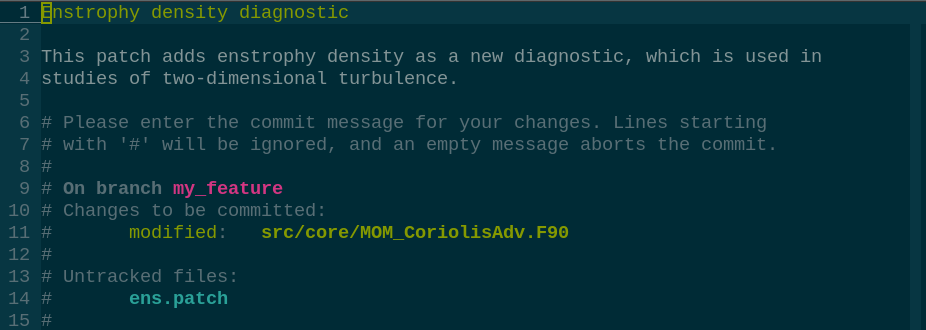
Commits as email
Pre-git, commits were emails sent to maintainers
- The message was the email (subject + body)
- The patch was an attachment
Emails follow a standard format (RFC 5822)
- "Lines … SHOULD be limited to 78 characters"
- Subject reduced to ~50, leave space for hash
The closer you follow these rules, the better the results
Linus Torvalds, Linux OSS 2020
Commit messages to me are almost as important as the code change itself.
If you can explain the code change to me, I will trust the code.
Preparing the Pull Request
GitHub handles pull requests (PRs) between repositories.
$ git fetch origin dev/gfdl # Update the target branch
$ git checkout my_feature # switch to feature
$ git rebase -i dev/gfdl # sync commits
$ git push marshall my_feature # Push to personal repoThe PR moves commits between repositories.
Minor Edits
Use amends and force pushes for minor changes:
$ vim src/my_file.F90 # Modify code
$ git add src/my_file.F90 # Add to commit
$ git commit --amend # Change the commit
$ git push --force marshall my_feature # Rewrite historyExamples:
- bugfixes
- whitespace fixes
- missing documentation
No one cares about typos! Don't put them in the history
Submit to MOM6
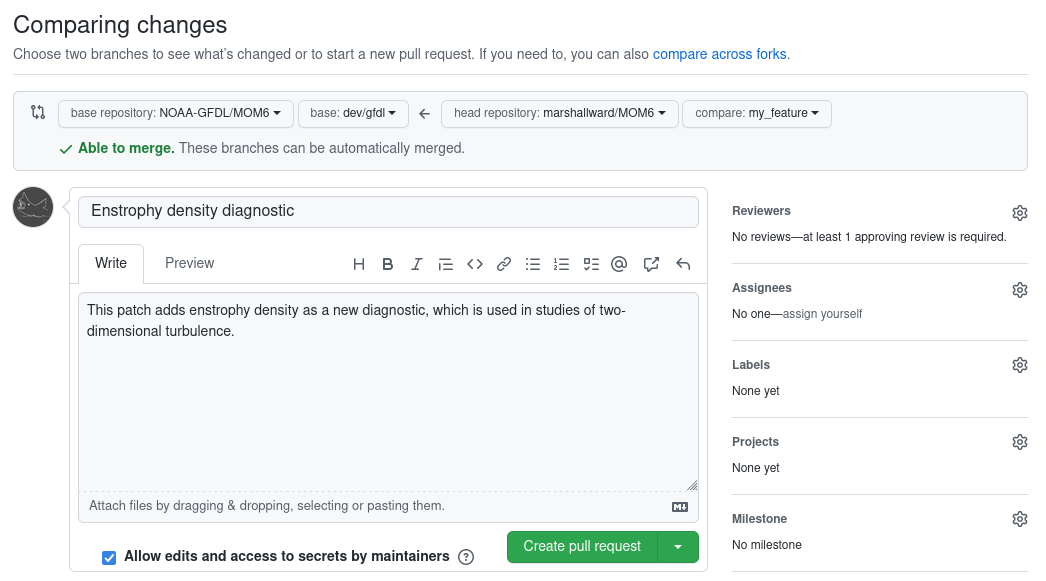
CI Testing
Continuous Integration checks all pull requests:
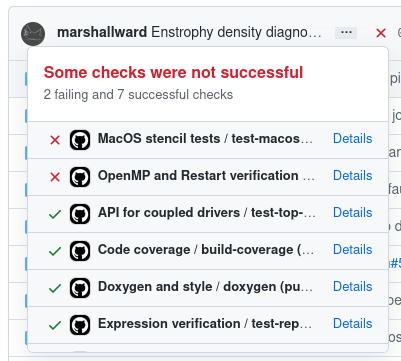
This one had problems!
.testing
GitHub Actions run the internal test suite
$ cd MOM6-examples/src/MOM6
$ cd .testing
$ make -j
$ make -j testdev/gfdlwas out of date (missing MacOS fix)- New variable needs to be in OpenMP directive
Gaea Regression
Final Approval
If all of the tests pass, then a human being (finally) evaluates the contribution.
Three options:
- Merge
- Rebase
- Squash
Merges preserve commits; the others change hashes!
Merge Types
 |
 |
| Merge | Squash |
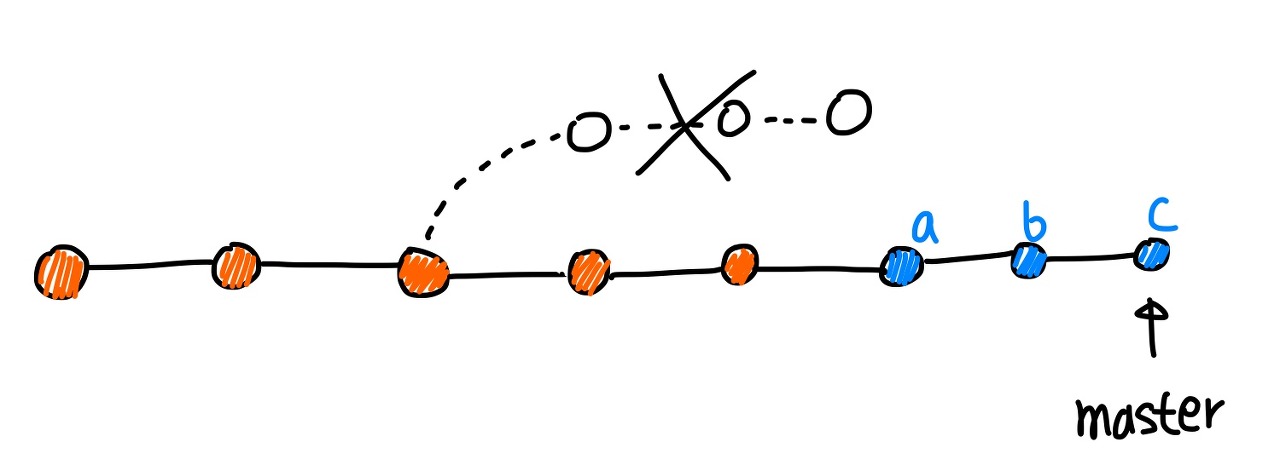
GitHub Merge
GitHub merges are "non-fast-forward". They create a merge commit.
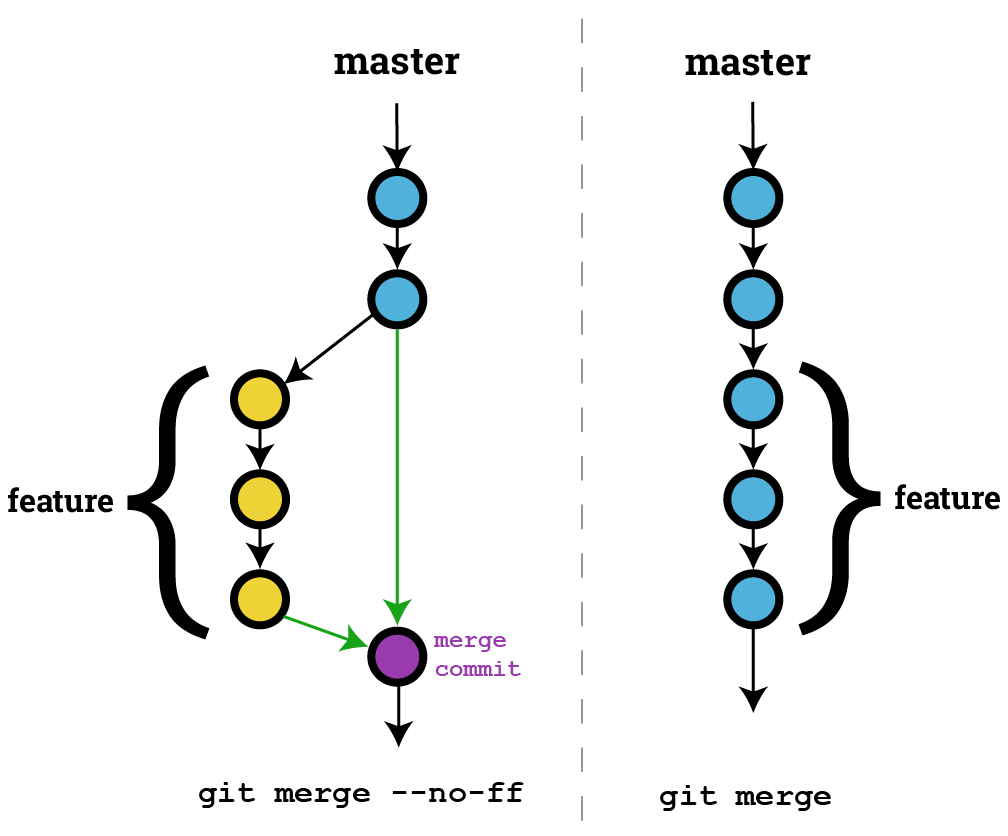
But FF merge is not always possible.
Summary
- Use git to manage your contributions
- Work on branches, submit back to
dev/gfdl - Commits should be meaningful
- Verified by automated testing
